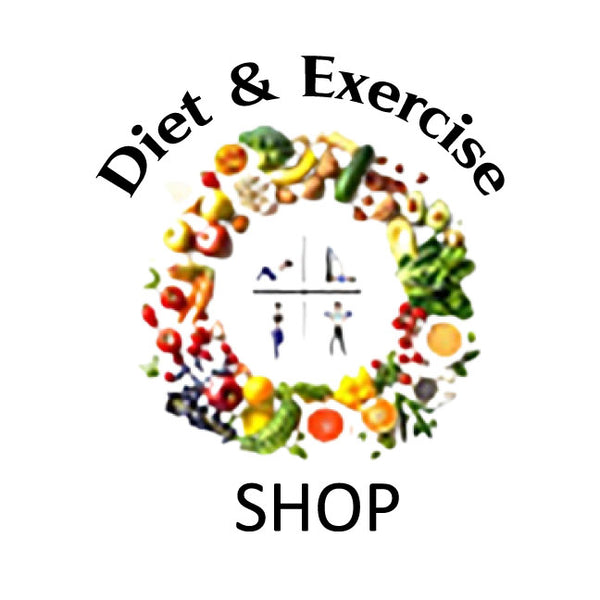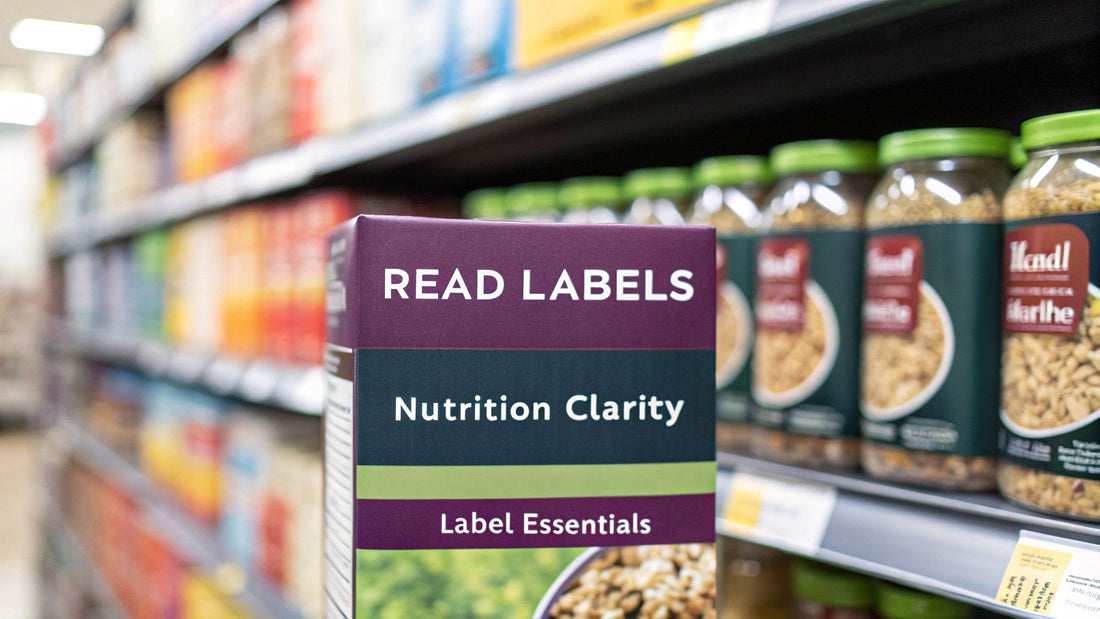
How to Read Nutrition Labels Easily for Better Food Choices
When you first pick up a package, forget everything else you see on the label. The marketing claims and long list of ingredients can wait.
I tell all my clients to start with a simple 60-second check. It’s a habit that will instantly prevent you from getting tripped up by foods that only seem healthy.
Your 60 Second Label Check
It’s easy to feel overwhelmed by that block of numbers and text on the back of a package. The trick is to cut through the noise and zero in on what matters most.
This isn't about a deep nutritional analysis; it's about building a fast, almost automatic habit to make smarter food choices.
First, your eyes should go directly to the serving size and the servings per container. This is always at the very top for a reason—it sets the context for everything else below it.
Honestly, this is where most people get tripped up. That small bag of pretzels might look like a harmless snack, but a quick glance reveals you just ate three servings, not one.
Right after that, look at the calories per serving. This number gives you a quick snapshot of the energy you’re about to consume.
Just by checking these two simple things, you can size up any food in under a minute and make a smarter call, even when you're in a hurry.
Why This Quick Check Works
This initial scan is your best defense against clever marketing. A brand can slap "healthy" on the front of a granola bar, but the label tells the real story.
You might find it has 250 calories per bar, and the package contains two of them. That "light" snack just turned into a 500-calorie decision.
The whole point is to connect the numbers on the package to the actual amount of food you're about to eat.
Getting that alignment right is the first step toward mindful eating and hitting your goals, whether that's creating a calorie deficit for weight loss or fueling up for a workout.
This simple habit makes a huge difference. Between 2017 and 2020, nearly 80% of adults reported using the Nutrition Facts panel regularly. You can learn more about these nutrition label trends and their findings to see how habits are shifting.
Putting It All Together
To make this second nature, build a mental checklist. Every time you pick up a product, just ask yourself two quick questions:
- How much is one serving, really? (Is it 1 cup, 8 crackers, or just half the bottle?)
- How many calories am I signing up for with that serving?
This quick assessment gives you immediate context. It helps you see how that food fits—or doesn't fit—into your day.
When you combine this awareness with your workouts, like strength training or cardio, your food choices start actively supporting all that hard work.
Tracking your intake with a tool like a food and nutrition journal can be a game-changer. This quick-look habit is the perfect foundation before diving deeper into macronutrients.
Here’s a quick reference table you can use to make this process even faster in the grocery aisle.
| Your Quick Label Assessment Checklist | ||
|---|---|---|
| Label Section | What to Look For | Why It Matters Most |
| Serving Size & Servings Per Container | The listed amount (e.g., 1 cup) and how many of those are in the package. | This number dictates the calories, fat, and sugar for everything else on the label. It’s your baseline. |
| Calories | The big, bold number right below the serving size. | This is a fast, at-a-glance measure of the energy you'll get from one serving. |
| Total Fat, Sodium & Added Sugars | Focus on limiting these three key nutrients first. | High intake is linked to health risks. A quick check here helps you avoid common dietary pitfalls. |
| Protein & Fiber | Look for higher numbers in these two sections. | These are your "satiety" nutrients—they help you feel full and satisfied, supporting muscle and digestive health. |
A quick scan of these four areas will give you 90% of what you need to know to make a solid choice.
A Closer Look at Your Macronutrients
Once you've got the hang of the quick scan, it's time to get into the details—the macronutrients. This is where you find the real fuel for your body: fats, carbohydrates, and protein.
Understanding these three is key to smart eating, especially if you have goals like losing weight or building muscle.
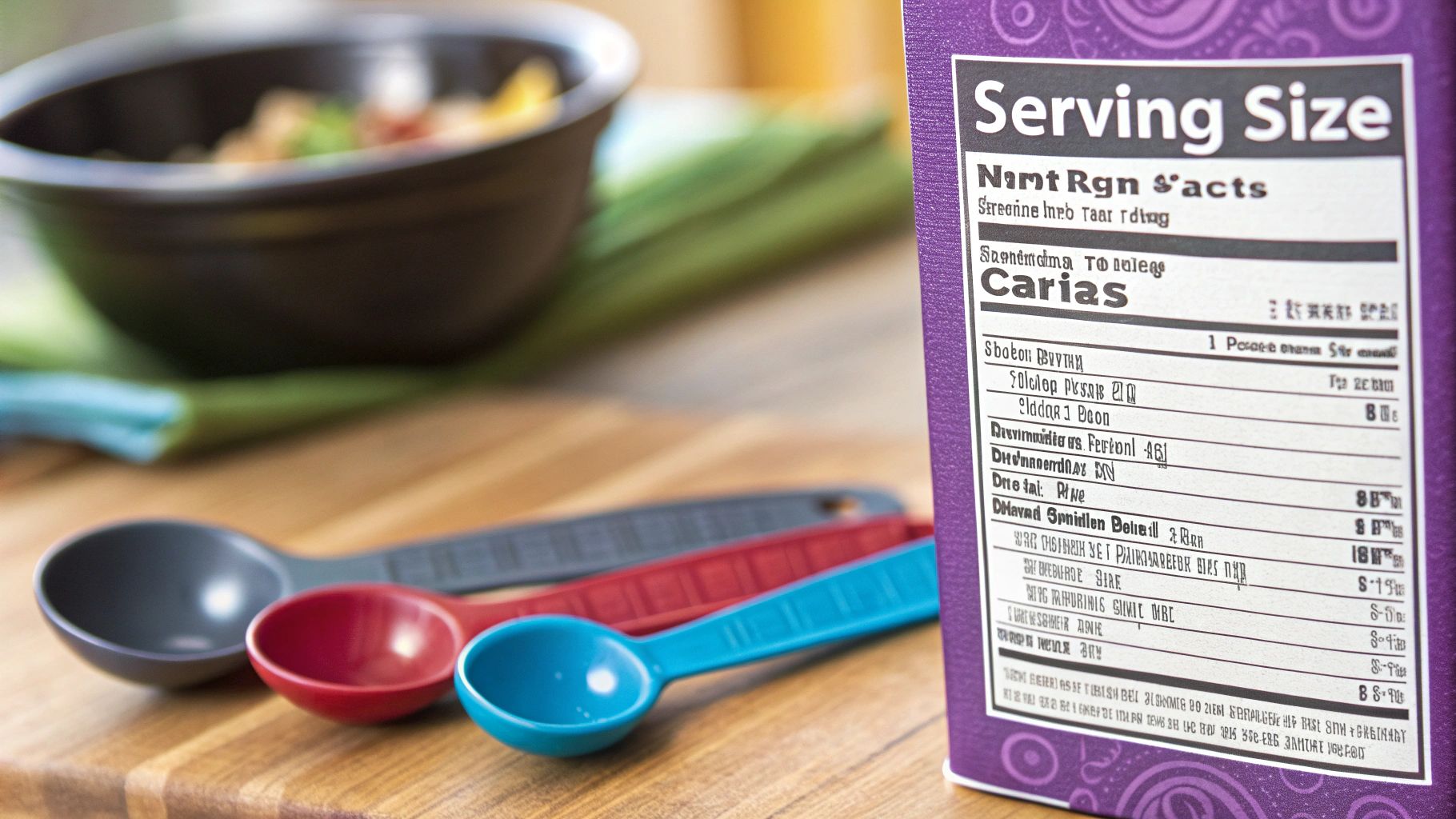
Let's start with fats. The label shows you Total Fat but then breaks it down into different types. This is a critical detail.
Focus on getting enough heart-healthy unsaturated fats while keeping an eye on saturated and trans fats. The quality of the fat you eat matters far more than the total quantity.
Navigating Carbs and Spotting Sneaky Sugars
Next up: carbohydrates, your body's main energy source. The label lists Total Carbohydrate, but the real story is in the breakdown: Dietary Fiber and Total Sugars.
For almost any health or fitness goal, the strategy is the same: get more fiber and less of one specific kind of sugar.
Dietary fiber is fantastic. It helps you feel full, keeps your digestive system happy, and can even help stabilize blood sugar levels.
Foods high in fiber are a secret weapon for weight management because they keep hunger at bay. Fiber is a huge part of how to achieve a sustainable calorie deficit.
Then you'll see a line for "Includes Added Sugars." Pay close attention to this one. This number tells you exactly how much sugar was put in during processing.
A good rule of thumb is to keep added sugars under 25 grams per day for women and 36 grams per day for men.
The natural sugar in an apple is bundled with fiber and vitamins. The added sugar in a can of soda? Just empty calories that can derail your progress.
Prioritizing Protein for Your Goals
Finally, we get to protein. It’s essential for repairing muscle and is a powerhouse for keeping you feeling full.
If you’re active, getting enough protein isn't optional—it’s a necessity for recovering from workouts and holding onto lean muscle, especially if you're in a calorie deficit.
How you look at the protein number really depends on what you're trying to achieve:
- For Weight Loss: Look for foods that are high in both protein and fiber. This combination keeps you full and satisfied while eating fewer calories.
- For Muscle Gain: You’ll want a high protein-to-calorie ratio to give your muscles fuel without a ton of extra calories.
Let's make this real. Imagine you're in the dairy aisle, deciding between two single-serving yogurts.
| Yogurt Comparison | Yogurt A (Fruit on the Bottom) | Yogurt B (Plain Greek) |
|---|---|---|
| Calories | 140 | 90 |
| Added Sugars | 12g | 0g |
| Protein | 6g | 16g |
At a glance, Yogurt A seems fine. But its 12g of added sugar and minimal protein make it more of a treat.
Yogurt B is a clear winner. It packs 16g of protein with zero added sugars, for fewer calories. This is how reading labels helps you choose food that fuels your body right.
Understanding Vitamins, Minerals, and Your Daily Values
Once you've sized up the macronutrients, your eyes should travel to the bottom of the label. This is where you'll find the micronutrients—the vitamins and minerals essential for your body.
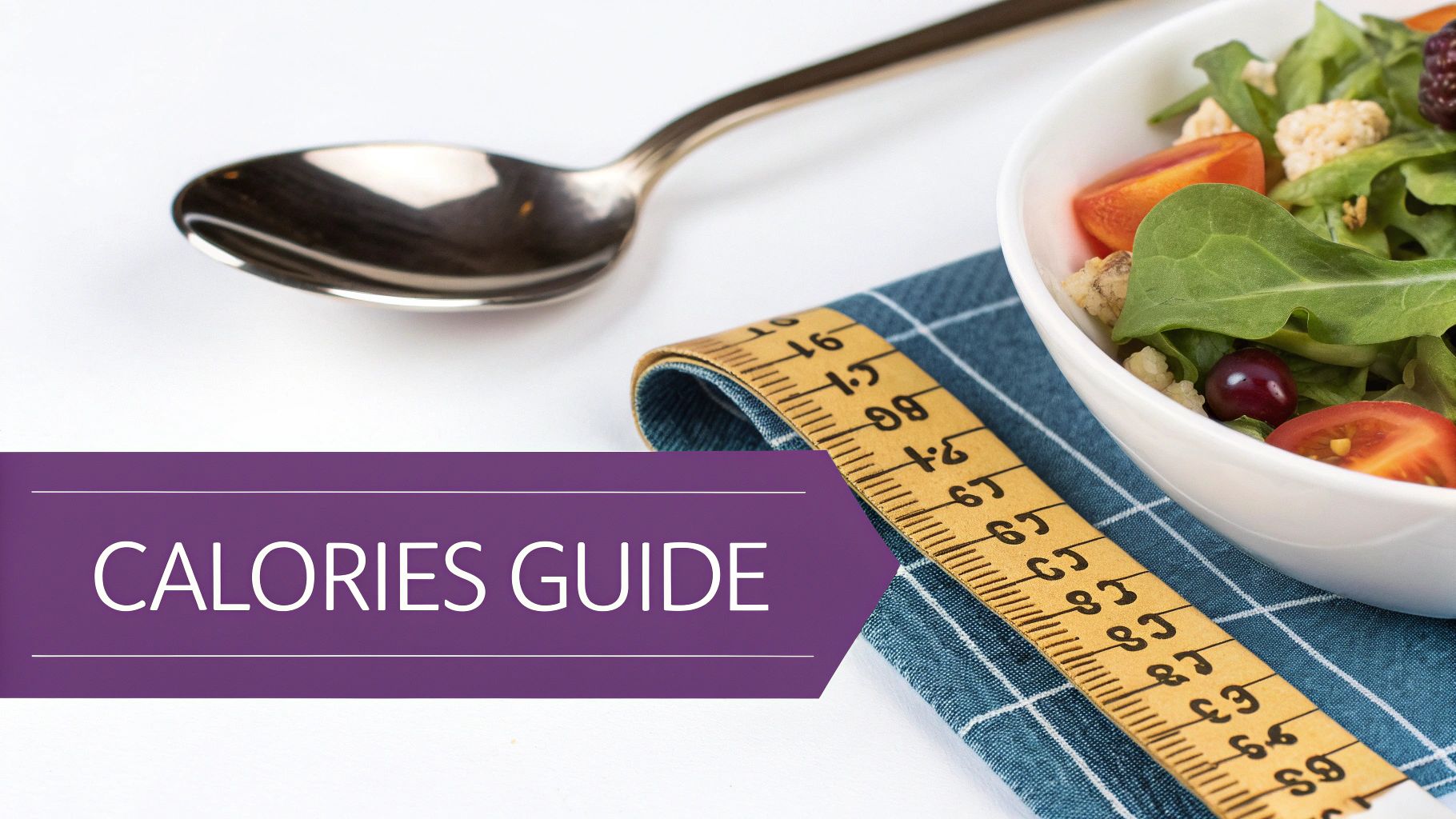
The FDA requires labels to highlight four key nutrients: Vitamin D, Calcium, Iron, and Potassium. Many of us don't get enough of these.
Knowing what these do is half the battle. For instance, pairing a high-calcium food with your workout routine helps build strong bones.
Making Sense of Percent Daily Value
The secret to quickly interpreting this section lies in the Percent Daily Value (%DV). It's a handy shortcut that tells you how much a nutrient in one serving contributes to your total daily needs.
These percentages are based on a 2,000-calorie diet, but they work as a fantastic general guide for almost everyone.
To make reading labels a breeze, use this simple rule of thumb:
- 5% DV or less per serving is considered low.
- 20% DV or more per serving is considered high.
This little trick is a game-changer. It lets you scan a label in seconds and know whether a food is packed with stuff you want more of (like fiber) or things you might want to cut back on (like sodium).
Putting Daily Values into Practice
Let's apply this. You're in the grocery aisle looking for a quick meal, and you pick up a can of soup. A glance shows the sodium is at 40% DV. That's a huge red flag!
Using the %DV rule, you can immediately spot that and grab a lower-sodium option instead. High sodium intake is a major player in high blood pressure.
The goal here is to pick foods that are nutrient-dense—packing a ton of vitamins and minerals for their calorie count.
This kind of label-reading skill makes a tangible difference. Research shows that when people pay attention to food labels, it can lead to significant health improvements. You can see the full research on food label effects.
This knowledge gives you the power to build a diet that genuinely fuels your body. It helps ensure your hard work at the gym is backed by a solid nutritional foundation.
If you're concerned about hitting all your micronutrient targets, supplementing can be a practical way to fill in the gaps. Products like Multivitamin Gummies are an easy way to cover your bases.
Reading the Ingredients List Like a Pro
The nutrition facts panel gives you the numbers, but the ingredients list tells the real story of what’s inside your food.
This is where you look to see past the flashy marketing claims on the front of the box.
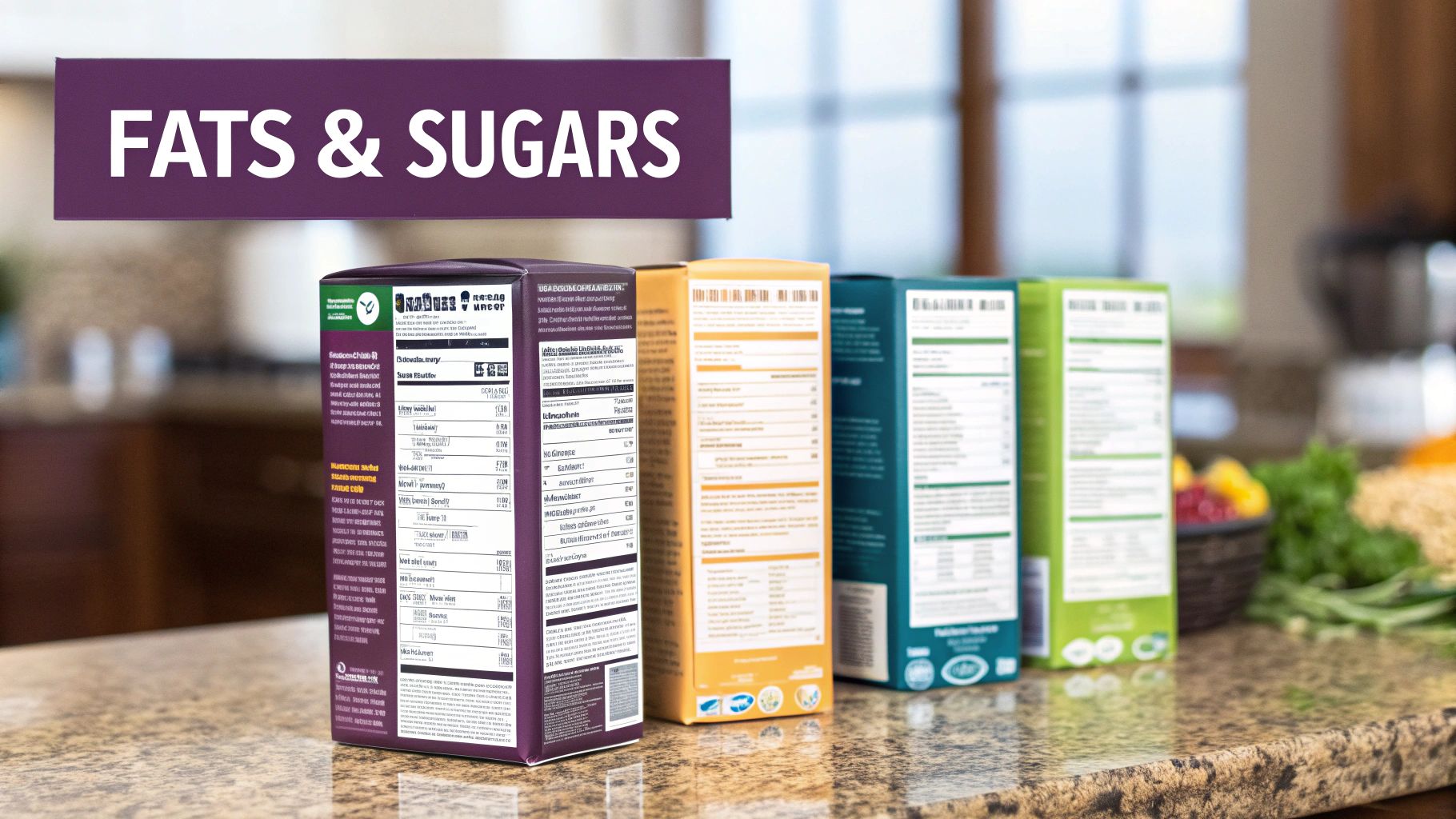
Here's the secret to decoding this list: ingredients are always listed in descending order by weight. This means the first one or two ingredients make up most of the product.
It’s the quickest way to spot a food that’s really just sugar or refined flour in disguise.
Think about a breakfast cereal. If "sugar" is the first thing you see, you can bet it's more of a dessert. You'd rather see a whole grain, like "whole wheat" or "oats," right at the top.
Unmasking Hidden Sugars
Food manufacturers have gotten clever about hiding sugar. They use dozens of different names for it, which makes it easy to overlook.
Keep an eye out for these common culprits:
- High-fructose corn syrup
- Dextrose or Maltodextrin
- Sucrose
- Cane juice or Cane syrup
- Agave nectar
- Barley malt
Ever see several of these scattered throughout a list? That’s a common tactic called "sugar-splitting." By using multiple sweeteners, companies avoid listing "sugar" as the number one ingredient.
Decoding Front-of-Package Claims
The front of the box is prime marketing real estate, often filled with phrases to make products sound healthier than they are. Terms like "All Natural," "Multigrain," or "Low-Fat" can be misleading.
A "low-fat" label doesn't automatically mean a product is healthy. Often, when companies remove fat, they load the product with extra sugar and sodium to make up for the lost flavor.
My advice? Always be skeptical of front-of-package claims. Let the nutrition label and the ingredients list have the final say.
Understanding these details separates good results from great ones. The fuel you choose is critical for performance and recovery, starting with picking foods based on substance, not hype.
To easily keep track of your meals, a tool like a digital food journal can be a huge help. It makes connecting the dots between your diet and your outcomes simple.
Applying Label Reading to Your Fitness Goals
Knowing how to decipher a nutrition label is a fantastic start, but the real magic happens when you use that information to fuel your body correctly.
This is where you connect the dots between the numbers on the package and your specific fitness goals, turning every food choice into a deliberate step forward.
It’s a powerful skill, yet it's shocking how often it goes unused. Many people still don't use labels to guide what they buy, a huge missed opportunity for making better choices.
Fueling for Weight Loss
If weight loss is your aim, the name of the game is satiety—that feeling of being full and satisfied on fewer calories.
Let’s say you’re comparing two frozen "diet" meals. Don't just glance at the calorie count. Look deeper.
Your mission is to find the option with higher protein and dietary fiber. That combination slows digestion and keeps hunger at bay for much longer, making it easier to stick to your calorie deficit.
A meal packing 20g of protein and 8g of fiber will serve you far better than one with just 10g of protein and 3g of fiber, even if the calories are nearly identical.
That’s the kind of strategic choice that gives you sustained energy for a workout instead of a post-meal energy crash.
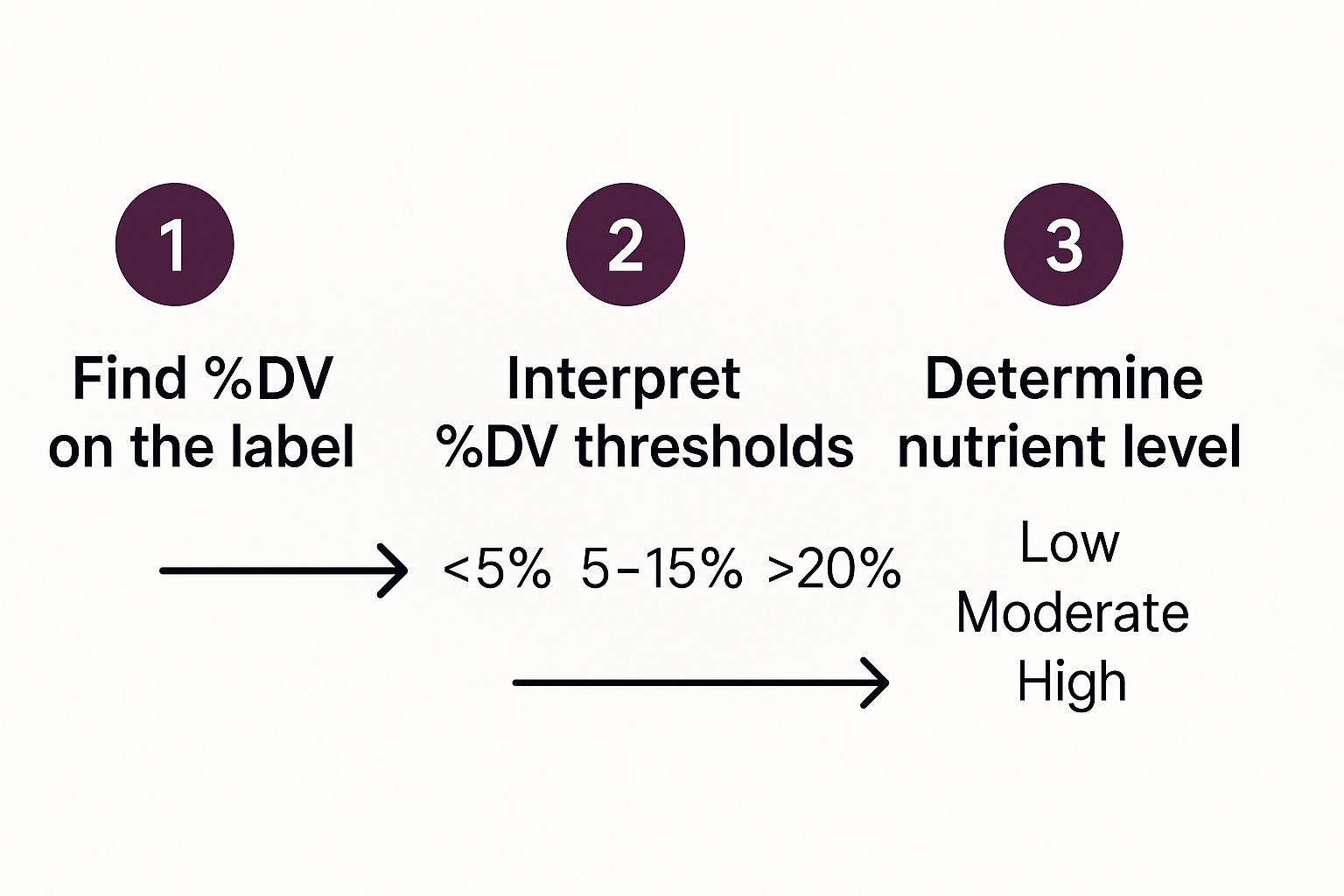
This simple guide to Percent Daily Value helps you quickly see if a nutrient is high or low. Use it to find foods rich in what you need and low in what you don’t.
Building Muscle Effectively
When your goal is building muscle, your focus shifts. Now, you’re on the hunt for a great protein-to-sugar ratio.
Imagine you're choosing between two protein bars. One boasts 20g of protein but is also loaded with 18g of added sugar. That’s basically a candy bar.
The smarter choice is the bar that also has 20g of protein but only 2g of sugar.
This isn't just about dodging sugar. It's about giving your muscles clean fuel to repair and grow. The right bar supports your hard work at the gym; the wrong one will spike your blood sugar.
What you eat directly impacts how your body adapts to training. To get a handle on this, it helps to learn more about body composition and see how nutrition and exercise work hand-in-hand.
Supporting General Health
Even if you aren't strictly trying to lose weight or bulk up, reading labels is fundamental for long-term health.
Think about buying bread. One package might say "multigrain," but the ingredients reveal the first item is refined wheat flour. The other loaf lists "100% whole grain" as the first ingredient.
The whole-grain option delivers far more fiber, vitamins, and minerals. By making these small, smart swaps every day, you’re building a diet that truly nourishes your body.
Tackling Tricky Questions on Nutrition Labels
Even when you feel you have the basics down, the grocery store can still throw you a curveball. Let's walk through a few common questions.
What’s the Deal With "Net Carbs"?
You've probably seen "net carbs" on keto-friendly snacks. The term is calculated by taking total carbs and subtracting fiber and sugar alcohols.
Here's the catch: "net carbs" isn't an official term recognized by the FDA.
My advice is to focus on the Total Carbohydrates line. Aim for sources high in dietary fiber and low in added sugars. This is the best way to get sustained energy for your workouts.
Why Do Some Labels Have Two Columns?
Ever see two columns of numbers on a pint of ice cream? That's a dual-column label, one of the most helpful updates the FDA has made.
These labels are required on products that could realistically be eaten in one go. One column lists the nutrition "per serving," and the other gives you the totals for the "per container."
It takes the guesswork out of the equation, showing you exactly what you're consuming if you eat the whole bag of chips.
This is a game-changer for syncing your food intake with your exercise. It gives you an honest, at-a-glance picture of the calories and macros you're really getting.
What if There's No Label at All?
If you're holding a fresh apple or spinach and can't find a label, that's usually a fantastic sign. It means you're looking at a whole, unprocessed food.
When you choose foods like these, you're naturally sidestepping the added sugars, sodium, and preservatives common in packaged goods.
If you do need the nutrition info, you can easily look it up on free, trusted online databases from sources like the USDA.
Nailing the nutrition label is a key skill for matching your diet to your fitness routine. To make it easier to track your meals and see how they're fueling your progress, the team at Diet & Exercise built the perfect tool. The Diet & Exercise Digital Food Journal helps you log your intake and connect the dots between what you eat and how you perform.
